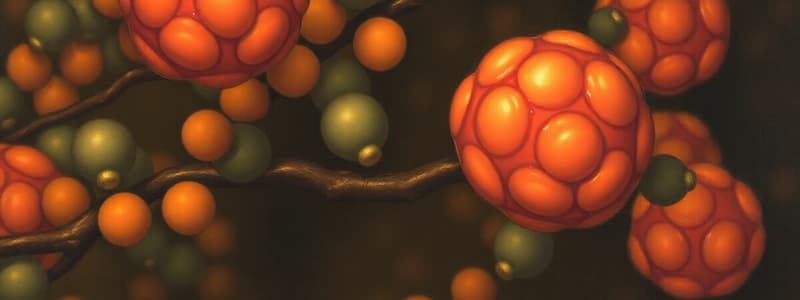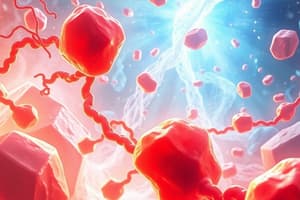Podcast
Questions and Answers
What type of proteins does the endosome–lysosome pathway primarily degrade?
What type of proteins does the endosome–lysosome pathway primarily degrade?
- Proteins from the nucleus
- Intracellular organelles
- Membrane-bound receptors only
- Extracellular and cell-surface proteins (correct)
What role does HDL play in cholesterol transport?
What role does HDL play in cholesterol transport?
- HDL delivers dietary triglycerides to adipocytes.
- HDL unloads triglycerides and remaining cholesterol directly into cells.
- HDL transfers cholesterol from peripheral cells back to the liver. (correct)
- HDL is involved in the degradation of misfolded proteins.
Which proteolytic pathway is specifically associated with degrading proteins from the cytoplasm, nucleus, and endoplasmic reticulum?
Which proteolytic pathway is specifically associated with degrading proteins from the cytoplasm, nucleus, and endoplasmic reticulum?
- Autophagic pathway
- Ubiquitin–proteasome pathway (correct)
- Mitochondrial pathway
- Endosome–lysosome pathway
How do chylomicrons function in cholesterol transport?
How do chylomicrons function in cholesterol transport?
How does the proteasome carry out protein degradation?
How does the proteasome carry out protein degradation?
What initiates the ERAD pathway?
What initiates the ERAD pathway?
What is a key feature of the mitochondrion's proteolytic system?
What is a key feature of the mitochondrion's proteolytic system?
What happens to misfolded proteins during the ERAD process?
What happens to misfolded proteins during the ERAD process?
Which enzyme is responsible for transferring ubiquitin from E1 to E2 in the ubiquitin-proteasome system?
Which enzyme is responsible for transferring ubiquitin from E1 to E2 in the ubiquitin-proteasome system?
What is the primary function of LDL in cholesterol transport?
What is the primary function of LDL in cholesterol transport?
What does the proteasome primarily degrade?
What does the proteasome primarily degrade?
What does feedback inhibition by cholesterol involve?
What does feedback inhibition by cholesterol involve?
What is the characteristic composition of the 26S proteasome?
What is the characteristic composition of the 26S proteasome?
Which of the following statements correctly describes the cooperation between the endosome–lysosome and ubiquitin–proteasome pathways?
Which of the following statements correctly describes the cooperation between the endosome–lysosome and ubiquitin–proteasome pathways?
What is the significance of Scavenger Receptor-B1 in cholesterol transport?
What is the significance of Scavenger Receptor-B1 in cholesterol transport?
What mechanism is paired with the transfer of misfolded proteins during ERAD?
What mechanism is paired with the transfer of misfolded proteins during ERAD?
What is the primary function of autophagy in cells?
What is the primary function of autophagy in cells?
Which type of autophagy involves the formation of an autophagosome?
Which type of autophagy involves the formation of an autophagosome?
What role does the protein hsc70 play in chaperone-mediated autophagy?
What role does the protein hsc70 play in chaperone-mediated autophagy?
What occurs after the outer membrane of an autophagosome fuses with a lysosome?
What occurs after the outer membrane of an autophagosome fuses with a lysosome?
Which of the following is NOT a type of autophagy?
Which of the following is NOT a type of autophagy?
Which factor has been linked to defects in autophagy?
Which factor has been linked to defects in autophagy?
In which type of autophagy are lysosomal membranes directly invaginated?
In which type of autophagy are lysosomal membranes directly invaginated?
What has become increasingly clear about the role of autophagy in non-starved cells?
What has become increasingly clear about the role of autophagy in non-starved cells?
What could lead to the accumulation of autophagic vacuoles in aging cells?
What could lead to the accumulation of autophagic vacuoles in aging cells?
How does the insulin receptor affect macroautophagy in aging cells?
How does the insulin receptor affect macroautophagy in aging cells?
What effect does an age-dependent decline in macroautophagy have on cells?
What effect does an age-dependent decline in macroautophagy have on cells?
What was observed in mice that followed a Fasting Mimicking Diet (FMD)?
What was observed in mice that followed a Fasting Mimicking Diet (FMD)?
What role does glucagon play in the process of macroautophagy?
What role does glucagon play in the process of macroautophagy?
Which consequence is most likely a result of inadequate turnover of organelles in aging cells?
Which consequence is most likely a result of inadequate turnover of organelles in aging cells?
What was a significant finding related to calorie restriction in mice?
What was a significant finding related to calorie restriction in mice?
What is a potential consequence of the failure of macroautophagy in older organisms?
What is a potential consequence of the failure of macroautophagy in older organisms?
What maintains the low lysosomal pH of 4-5?
What maintains the low lysosomal pH of 4-5?
What is the primary function of the acid hydrolases present in lysosomes?
What is the primary function of the acid hydrolases present in lysosomes?
Which transporter activates mTOR in response to luminal arginine?
Which transporter activates mTOR in response to luminal arginine?
What role does mTORC1 play in cellular processes?
What role does mTORC1 play in cellular processes?
What does the cellular export of cholesterol from lysosomes primarily involve?
What does the cellular export of cholesterol from lysosomes primarily involve?
Why is solute efflux important in lysosomes?
Why is solute efflux important in lysosomes?
What distinguishes proton-coupled amino acid transporters from typical amino acid transporters?
What distinguishes proton-coupled amino acid transporters from typical amino acid transporters?
Which of the following is NOT a function of mTOR?
Which of the following is NOT a function of mTOR?
What is the function of S6K1 in mRNA translation initiation?
What is the function of S6K1 in mRNA translation initiation?
Which component is a part of the mTOR Complex 1 (mTORC1)?
Which component is a part of the mTOR Complex 1 (mTORC1)?
How does mTORC1 regulate mRNA translation at the ribosome?
How does mTORC1 regulate mRNA translation at the ribosome?
Which factor is NOT involved in the regulation of mTORC1 activity?
Which factor is NOT involved in the regulation of mTORC1 activity?
What role does 4EBP play in translation regulation?
What role does 4EBP play in translation regulation?
Which amino acid has been noted as a significant regulator in mTORC1 signaling?
Which amino acid has been noted as a significant regulator in mTORC1 signaling?
What mechanism leads to the recruitment of mTORC1 to the lysosome?
What mechanism leads to the recruitment of mTORC1 to the lysosome?
What is a primary role of mTORC1 in ribosome biogenesis?
What is a primary role of mTORC1 in ribosome biogenesis?
Flashcards
Cholesterol Transport to Liver
Cholesterol Transport to Liver
Cholesterol from cells is picked up by HDL and taken back to the liver.
LDL Receptor Uptake
LDL Receptor Uptake
LDL cholesterol is taken by peripheral cells or liver by specific receptor.
Chylomicron Delivery
Chylomicron Delivery
Fat from food is carried by chylomicrons to fat cells (adipocytes).
ERAD Pathway
ERAD Pathway
Signup and view all the flashcards
Quality Control Receptors
Quality Control Receptors
Signup and view all the flashcards
ER-Membrane-Associated Complex
ER-Membrane-Associated Complex
Signup and view all the flashcards
Protein Degradation
Protein Degradation
Signup and view all the flashcards
Feedback Inhibition
Feedback Inhibition
Signup and view all the flashcards
Endosome-lysosome pathway
Endosome-lysosome pathway
Signup and view all the flashcards
Ubiquitin-Proteasome pathway
Ubiquitin-Proteasome pathway
Signup and view all the flashcards
Mitochondrial proteolytic system
Mitochondrial proteolytic system
Signup and view all the flashcards
Proteasome
Proteasome
Signup and view all the flashcards
Ubiquitin-Proteasome system (UPS)
Ubiquitin-Proteasome system (UPS)
Signup and view all the flashcards
Autophagy
Autophagy
Signup and view all the flashcards
Target protein and ubiquitin ligase
Target protein and ubiquitin ligase
Signup and view all the flashcards
26S proteasome
26S proteasome
Signup and view all the flashcards
Macroautophagy
Macroautophagy
Signup and view all the flashcards
Autophagosome
Autophagosome
Signup and view all the flashcards
Lysosome
Lysosome
Signup and view all the flashcards
Microautophagy
Microautophagy
Signup and view all the flashcards
Chaperone-mediated autophagy
Chaperone-mediated autophagy
Signup and view all the flashcards
Ubiquitination
Ubiquitination
Signup and view all the flashcards
Lysosomal pH
Lysosomal pH
Signup and view all the flashcards
V-ATPase
V-ATPase
Signup and view all the flashcards
Acid Hydrolases
Acid Hydrolases
Signup and view all the flashcards
SLC Transporters
SLC Transporters
Signup and view all the flashcards
Amino Acid Sensing Machinery
Amino Acid Sensing Machinery
Signup and view all the flashcards
mTOR
mTOR
Signup and view all the flashcards
Nutrient Acquisition
Nutrient Acquisition
Signup and view all the flashcards
Proton-Coupled Amino Acid Transporters
Proton-Coupled Amino Acid Transporters
Signup and view all the flashcards
Autophagy Failure in Aging
Autophagy Failure in Aging
Signup and view all the flashcards
Lipofuscin Accumulation
Lipofuscin Accumulation
Signup and view all the flashcards
Glucagon Signaling Decline
Glucagon Signaling Decline
Signup and view all the flashcards
Mitochondrial Dysfunction
Mitochondrial Dysfunction
Signup and view all the flashcards
Increased Free Radical Production
Increased Free Radical Production
Signup and view all the flashcards
Autophagy and Longevity
Autophagy and Longevity
Signup and view all the flashcards
Fasting Mimicking Diet (FMD)
Fasting Mimicking Diet (FMD)
Signup and view all the flashcards
Regenerative Effects of FMD
Regenerative Effects of FMD
Signup and view all the flashcards
What is S6K1?
What is S6K1?
Signup and view all the flashcards
What is mTORC1?
What is mTORC1?
Signup and view all the flashcards
How does mTORC1 get activated?
How does mTORC1 get activated?
Signup and view all the flashcards
How does mTORC1 affect translation?
How does mTORC1 affect translation?
Signup and view all the flashcards
What is the role of Rags in mTORC1 activation?
What is the role of Rags in mTORC1 activation?
Signup and view all the flashcards
How does mTORC1 influence ribosome biogenesis?
How does mTORC1 influence ribosome biogenesis?
Signup and view all the flashcards
What is the role of mTORC1 in mRNA translation?
What is the role of mTORC1 in mRNA translation?
Signup and view all the flashcards
How does mTORC1 affect overall protein synthesis?
How does mTORC1 affect overall protein synthesis?
Signup and view all the flashcards
Study Notes
Dietary Cholesterol Movement
- Cholesterol from the diet travels to the liver.
- HDL (high-density lipoprotein) collects cholesterol from peripheral cells and returns it to the liver.
- Cholesterol from cell membranes is loaded into HDL.
- VLDL (very-low-density lipoprotein) releases triglycerides and remaining cholesterol to the liver or peripheral cells via LDL receptors.
- Chylomicrons deliver dietary triglycerides to adipocytes and remnants are taken to the liver.
Cholesterol Feedback Inhibition
- Cholesterol regulates its own production via feedback inhibition.
- Feedback inhibition is a regulatory mechanism where the product of a metabolic pathway (in this case, cholesterol) inhibits an enzyme in the pathway, slowing the production of more product.
ERAD Pathway
- ERAD (endoplasmic reticulum-associated degradation) is a cellular pathway for degrading misfolded or unassembled proteins in the endoplasmic reticulum (ER).
- ERAD targets proteins to the cytosol for proteasomal degradation.
- Proteins are recognized as aberrant by quality control receptors in the ER.
- These misfolded proteins are then sorted to an ER membrane complex that includes adaptor proteins and an ERAD substrate.
- This process often involves ubiquitination during transport across the ER.
- Retrotranslocation complexes extract the ERAD substrate and prepare it for proteasomal degradation.
Proteolytic Pathways in Cells
- The endosome-lysosome pathway targets extracellular and cell-surface proteins for degradation.
- Intracellular organelles also enter this pathway.
- The ubiquitin-proteasome pathway (UPS) targets cytoplasmic, nuclear, and ER proteins for degradation.
- Mitochondria also have a proteolytic system.
- Evidence suggests cooperation between these pathways.
Autophagy
- Autophagy is a cellular process of degradation and recycling of cellular components.
- Autophagy is regulated and can play a role in cell homeostasis.
- Defects in autophagy have links to several human diseases, including neurodegeneration and cancer.
- Macroautophagy, microautophagy, and chaperone-mediated autophagy are three common types.
Ubiquitin-Proteasome System (UPS)
- The UPS is a cellular pathway for targeted protein degradation.
- It involves ubiquitin, an enzyme called E1, E2, and E3 ligase, and finally, the proteasome.
Consequences of Autophagy Failure
- Protein aggregates may accumulate
- Organelle turnover is impaired
- Free radicals may increase
- Energetic compromise can result in the aging cells
Metabolic Health and Life Span
- Promoting autophagy may improve metabolic health and lifespan.
- Researchers have discovered that periodic fasting mimicking diets can extend lifespan in mice.
mTOR Regulates Cell Growth and Metabolism
- mTOR plays a crucial role in regulating energy balance by controlling protein, lipid, and nucleotide synthesis, lysosome autophagy, and biogenesis.
- mTORC1 and mTORC2 are the two complexes in the mTOR pathway.
- mTORC1 and mTORC2 are regulated by a series of mechanisms.
Amino Acid Sensing and the Lysosome
- Amino acid sensing (specifically arginine) is a crucial regulator of lysosomal function.
- The activation of the Rag proteins (RagA/B/C/D) and SLC38A9 aminoacid transporter, which detects and relays arginine signals from the lysosome to the mTORC1 pathway directly.
- mTORC1 is activated.
Ribosome Production and Regulation
- mTORC1 positively regulates several steps in ribosome biogenesis, including rRNA transcription, ribosomal protein synthesis, and ribosome components.
- Specific mRNAs can be regulated by mTOR.
Studying That Suits You
Use AI to generate personalized quizzes and flashcards to suit your learning preferences.
Related Documents
Description
This quiz covers the important mechanisms of dietary cholesterol movement, feedback inhibition, and the ERAD pathway. Test your knowledge on how cholesterol is transported, regulated, and degraded in the body. Perfect for students studying biochemistry and cellular biology.




